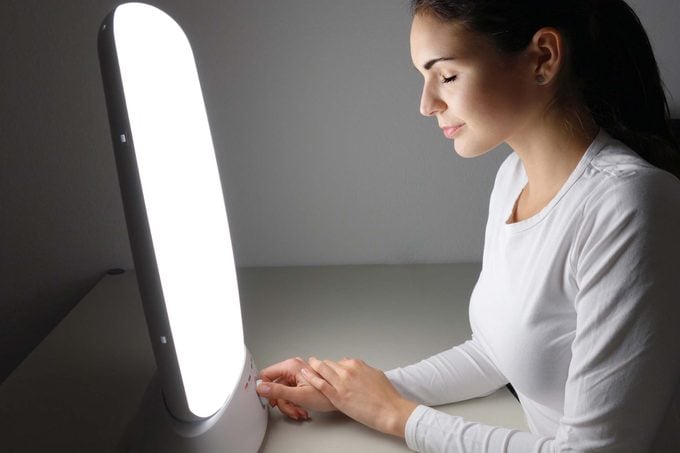I Used a Light Therapy Lamp for Depression. Here’s How It Changed Me.
Updated: Mar. 08, 2022
Learn how light box therapy helped one woman cope with intense feelings of depression and exhaustion related to seasonal affective disorder.
Our editors and experts handpick every product we feature. We may earn a commission from your purchases.

There are a few things that are more disconcerting than being woken up by a bright light. Its unexpectedness is almost as startling as the temporary blindness that follows. Odd as it may seem, this sensation isn’t all that different from light box therapy, a common treatment for seasonal affective disorder. SAD is a type of depression brought on by seasonal changes, typically when fall turns into winter (though for some people, the spring and early summer months are triggers).
Light therapy lamps can help counteract those feelings with a type of light that can activate mood-boosting hormones. (Here’s what you need to know about summer seasonal affective disorder.
SAD affects about 5% of U.S. adults and can last about 40% of the year, according to the American Psychiatric Association. SAD rates increase notably in northern states, where there’s naturally less sunlight. Symptoms typically start to appear between ages 20 and 30, and women are three to five times more likely to develop symptoms than men. (Here are 14 little ways to try to avoid SAD.)
As a 22-year-old woman from suburban Wisconsin, I’m a prime target. I never understood why winter was such a hard time for me until a college counselor introduced me to light therapy. It’s been two years since I last used my light box, but when the nights started to grow longer and the days get colder, I decided it was a good time to take it out of retirement.
SAD: The most appropriate acronym ever
Symptoms of SAD can be similar to those of major depression, like feeling hopeless and drained of energy, losing interest in activities you love, and suicidal thoughts. But Craig Sawchuk, PhD, a clinical psychologist at the Mayo Clinic in Rochester, Minnesota, describes the signs that distinguish SAD from other forms of depression as “hibernation-like symptoms”: excess sleep, increased appetite, cravings for carbs, weight gain, and overall sluggish feelings.
Light boxes are made to treat and prevent those feelings with the specific type and intensity of their lights, measured in lux (the typical intensity is 10,000 lux). Our circadian rhythm is what helps us stay awake during the day and sleep at night, but it can be thrown out of whack by the extended darkness winter brings. By delivering light directly through the retina, light boxes help the hormones serotonin and dopamine kick in, which resets the circadian rhythm. “It’s like a control-alt-delete where we reset our biological clock,” Sawchuk says.
It’s best to turn on the light within an hour of getting up, so it can help your body wake up as well. So every morning, I woke up, made breakfast, and sat down with the light box about three feet in front of me. The box was only a bit bigger than the latest iPhone, but its intense blue light was as bright as the noon sun on a spring day. After just a few minutes of it shining on me, I got used to its high intensity. This would be a breeze.
Not so much. The instantaneous mood boost I was expecting never came. In fact, the next day, I started feeling more depressed. All I could think about was getting back in bed. I felt homesick for the first time since moving away from my family three months ago. (Read why low-grade depression is on the rise.)
Sawchuk later explained to me that an intensification of symptoms can be a side effect for some people. But more common side effects are feeling more anxious and restless, getting headaches, and sudden behavioral changes.
Be patient: The results are worth it
Some people need two or three weeks before they start feeling the light box’s effects kick in. But about a week after I started using it, something changed. I was less cranky when I woke up. Getting out of bed didn’t seem like the end of the world. The homesickness settled down. Even though it was still dark when I left my apartment for work, I felt surprisingly awake.
One morning, my train to work was delayed 20 minutes because of a broken track. Some people groaned. Others complained. I didn’t. Yes, I wouldn’t get to work when I wanted to, but I had 20 more minutes to myself, 20 minutes to sit and relax. My new mood allowed me to make the most of a situation that was out of my control.
It’s important to keep using the light box even after you start feeling better. SAD isn’t a one-time thing. It’s a condition that requires continual treatment. You wouldn’t work out for just one day to get in better physical shape, would you?